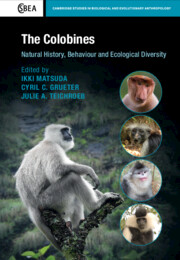Book contents
- The Colobines
- Cambridge Studies in Biological and Evolutionary Anthropology
- The Colobines
- Copyright page
- Contents
- Contributors
- Foreword
- Acknowledgements
- 1 General Introduction
- 2 Taxonomic Classification of Colobine Monkeys
- 3 The Colobine Fossil Record
- 4 Molecular Phylogeny and Phylogeography of Colobines
- 5 Relationships between the Diet and Dentition of Asian Leaf Monkeys
- 6 Morphology and Physiology of Colobine Digestive Tracts
- 7 Colobine Gut Microbiota
- 8 Colobine Nutritional Ecology
- 9 Red Colobus Natural History
- 10 Natural History of Black-and-White Colobus Monkeys
- 11 Behaviour and Ecology of Olive Colobus
- 12 Ecology and Behaviour of Odd-Nosed Colobines
- 13 Ecology of Semnopithecus
- 14 Ecology of Sympatric and Allopatric Presbytis and Trachypithecus Langurs in Sundaland
- 15 Ecology of Trachypithecus spp. in the Indo-Burmese Region
- 16 Socioecology of Asian Colobines
- 17 Socioecology of African Colobines
- 18 Causes and Consequences of the Formation of Multilevel Societies in Colobines
- 19 Colobine Population Ecology
- 20 State of Asian Colobines and Their Conservation Needs
- 21 Conservation of Africa’s Colobine Monkeys (Cercopithecidae, Colobinae) with Taxonomic and Biogeographic Considerations
- 22 Directions for Future Research
- References
- Index
14 - Ecology of Sympatric and Allopatric Presbytis and Trachypithecus Langurs in Sundaland
Published online by Cambridge University Press: 08 February 2022
- The Colobines
- Cambridge Studies in Biological and Evolutionary Anthropology
- The Colobines
- Copyright page
- Contents
- Contributors
- Foreword
- Acknowledgements
- 1 General Introduction
- 2 Taxonomic Classification of Colobine Monkeys
- 3 The Colobine Fossil Record
- 4 Molecular Phylogeny and Phylogeography of Colobines
- 5 Relationships between the Diet and Dentition of Asian Leaf Monkeys
- 6 Morphology and Physiology of Colobine Digestive Tracts
- 7 Colobine Gut Microbiota
- 8 Colobine Nutritional Ecology
- 9 Red Colobus Natural History
- 10 Natural History of Black-and-White Colobus Monkeys
- 11 Behaviour and Ecology of Olive Colobus
- 12 Ecology and Behaviour of Odd-Nosed Colobines
- 13 Ecology of Semnopithecus
- 14 Ecology of Sympatric and Allopatric Presbytis and Trachypithecus Langurs in Sundaland
- 15 Ecology of Trachypithecus spp. in the Indo-Burmese Region
- 16 Socioecology of Asian Colobines
- 17 Socioecology of African Colobines
- 18 Causes and Consequences of the Formation of Multilevel Societies in Colobines
- 19 Colobine Population Ecology
- 20 State of Asian Colobines and Their Conservation Needs
- 21 Conservation of Africa’s Colobine Monkeys (Cercopithecidae, Colobinae) with Taxonomic and Biogeographic Considerations
- 22 Directions for Future Research
- References
- Index
Summary
In insular Southeast Asia Presbytis and Trachypithecus langurs show a complex distribution pattern whereby in certain areas only one species is present, in other areas two or three species of the same genus live sympatrically, and in yet other areas two, three or even four species of the two genera co-exist. Given their morphological similarity it is intriguing to unravel the ecological differences that allow these species to live side by side. Presbytis langurs are more confined to wet forests than Trachypithecus langurs; their range includes drier regions, high mountains and small islands. In terms of diet (young, old leaves, fruits, seeds) or activity budgets there is a large variation within species and no clear difference between co-occuring species emerges. Home range sizes for Presbytis langurs (~35 ha) is larger than those for Trachypithecus langurs (~20 ha), but day ranges appear to be more similar (~500 to 1,500 m). The variation in group sizes and composition (especially the number of adult males) differs in that Presbytis langurs typically live in smaller groups (~5 to 12 individuals), mostly with one adult male, than Trachypithecus langurs groups (frequently over 20 individuals) that frequently have two or more adult males present.
Keywords
- Type
- Chapter
- Information
- The ColobinesNatural History, Behaviour and Ecological Diversity, pp. 199 - 224Publisher: Cambridge University PressPrint publication year: 2022



